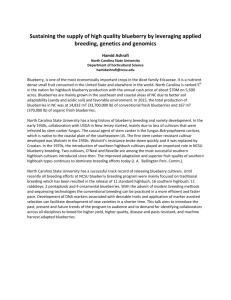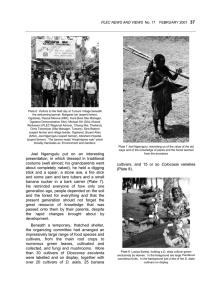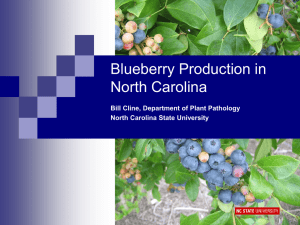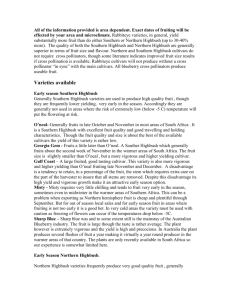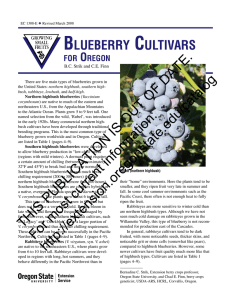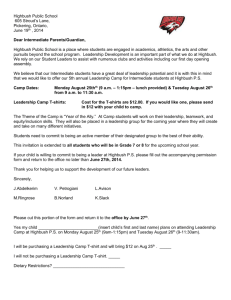Archival copy. For current version, see:
advertisement
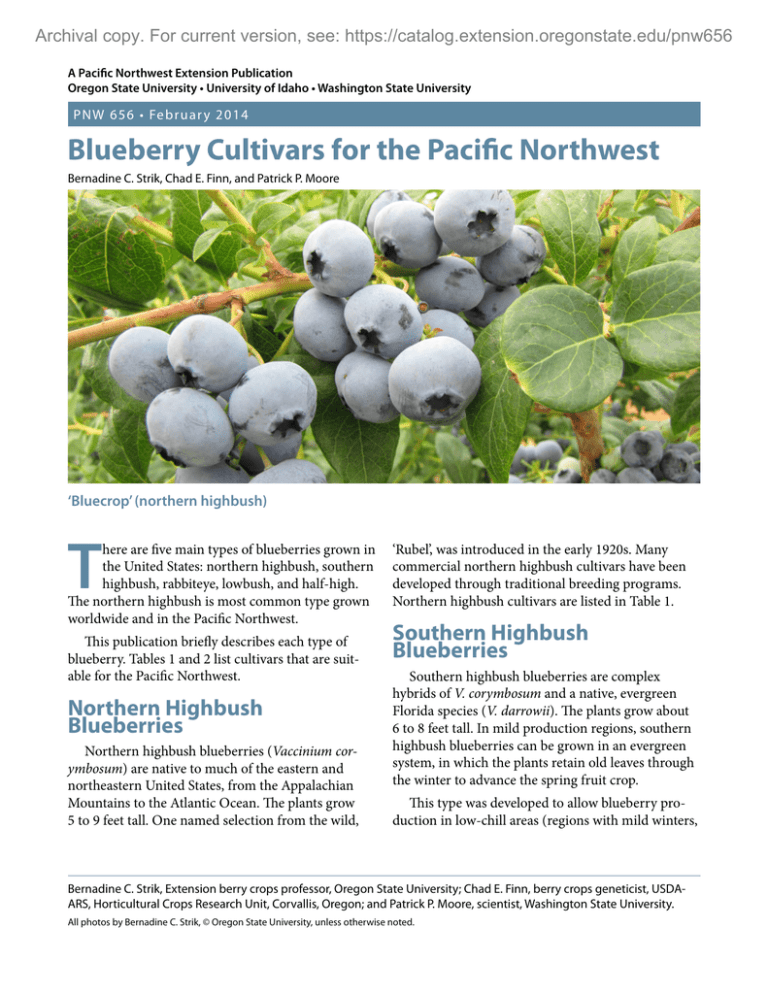
Archival copy. For current version, see: https://catalog.extension.oregonstate.edu/pnw656 A Pacific Northwest Extension Publication Oregon State University • University of Idaho • Washington State University PNW 656 • Februar y 2014 Blueberry Cultivars for the Pacific Northwest Bernadine C. Strik, Chad E. Finn, and Patrick P. Moore ‘Bluecrop’ (northern highbush) T here are five main types of blueberries grown in the United States: northern highbush, southern highbush, rabbiteye, lowbush, and half-high. The northern highbush is most common type grown worldwide and in the Pacific Northwest. This publication briefly describes each type of blueberry. Tables 1 and 2 list cultivars that are suitable for the Pacific Northwest. Northern Highbush Blueberries Northern highbush blueberries (Vaccinium corymbosum) are native to much of the eastern and northeastern United States, from the Appalachian Mountains to the Atlantic Ocean. The plants grow 5 to 9 feet tall. One named selection from the wild, ‘Rubel’, was introduced in the early 1920s. Many commercial northern highbush cultivars have been developed through traditional breeding programs. Northern highbush cultivars are listed in Table 1. Southern Highbush Blueberries Southern highbush blueberries are complex hybrids of V. corymbosum and a native, evergreen Florida species (V. darrowii). The plants grow about 6 to 8 feet tall. In mild production regions, southern highbush blueberries can be grown in an evergreen system, in which the plants retain old leaves through the winter to advance the spring fruit crop. This type was developed to allow blueberry production in low-chill areas (regions with mild winters, Bernadine C. Strik, Extension berry crops professor, Oregon State University; Chad E. Finn, berry crops geneticist, USDAARS, Horticultural Crops Research Unit, Corvallis, Oregon; and Patrick P. Moore, scientist, Washington State University. All photos by Bernadine C. Strik, © Oregon State University, unless otherwise noted. Archival copy. For current version, see: https://catalog.extension.oregonstate.edu/pnw656 ‘Bluejay’ (northern highbush) ‘Powderblue’ (rabbiteye) such as Florida and California). A dormant blueberry plant requires a certain amount of chilling (between approximately 32°F and 45°F) to break bud and flower normally. Southern highbush blueberries have a much lower chilling requirement (200 to 300 hours) than northern highbush blueberries (more than 800 hours). Rabbiteye blueberries are more sensitive to winter cold than northern highbush blueberries. Although we have not seen much cold damage on rabbiteyes grown in Oregon’s Willamette Valley, cold damage to flower buds and late-season growth has been observed when temperatures drop below approximately 0°F to 5°F. We do not recommend this type of blueberry for production east of the Cascades or in northern Washington. Southern highbush blueberries will grow in the Pacific Northwest but have low yields. Bushes bloom in late winter, and flowers are frequently damaged by frost. We do not recommend southern highbush blueberry cultivars for the Pacific Northwest. Some hybrid cultivars, such as ‘Legacy’ and ‘Ozarkblue’, can be grown successfully west of the Cascades; however, cold damage to flower buds has been observed in these cultivars when temperatures drop below approximately 0°F to 5°F. Rabbiteye Blueberries Rabbiteye blueberries (V. virgatum syn. V. ashei) are native to the southeastern United States. The plants grow from 6 to 10 feet tall. Rabbiteye cultivars were developed in regions with long, hot summers, and they behave differently in the Pacific Northwest than in their home environments. In this region, the plants tend to be smaller, and the fruit ripens very late in summer and fall. In some cool summer environments, such as the Pacific Coast and northwest Washington, there often is not enough heat to fully ripen the fruit. 2 Though newer cultivars have fruit quality similar to that of highbush types, many older rabbiteye cultivars have darker blue fruit with more noticeable seeds, thicker skins, and noticeable grit or stone cells (as found in pears). Rabbiteye cultivars are listed in Table 1. Lowbush Blueberries Lowbush blueberries (V. angustifolium) are native from Minnesota to Virginia and to the northeastern United States and the Maritime Provinces of Canada. The plants are low-growing shrubs that spread by underground stems; they seldom grow taller than 1.5 feet. A few cultivars, such as ‘Blomidon’, ‘Burgundy’, and ‘Brunswick’, have been named, but the lowbush blueberry industry depends on managing wild stands made up of hundreds or thousands of clones per acre. Plant more than one cultivar for good fruit production. In general, lowbush types need little pruning, but cut plants back to the ground every 2 to 3 years if they get too shrubby. Archival copy. For current version, see: https://catalog.extension.oregonstate.edu/pnw656 Half-High Blueberries Half-high blueberries are the result of crosses between northern highbush and lowbush blueberries. These cultivars will tolerate -35°F to -45°F. The plants grow from 3 to 4 feet tall, and most of the fruiting area is protected below the snow line. Half-high blueberries are suitable for commercial production where other types of blueberry are not hardy. They are also used as attractive landscape plants and are suited to container production. In the landscape, they do not need to be pruned as severely or as regularly as highbush types. Half-high cultivars are listed in Table 2. Pollination ‘Pink Lemonade’ (rabbiteye) Cultivars for Colder Growing Regions, Limited Space, or Container Production Although most commercial blueberry production in Oregon is west of the Cascades, northern highbush blueberries are successfully grown in eastern Washington, some areas of Idaho, and eastern Oregon. In these regions, growers must contend with shorter growing seasons and colder winter temperatures, and selection of cold-hardy cultivars and protection from spring frost damage are especially important. Harvest dates vary tremendously among cultivars, but cultivars bloom within about a week of one another. Thus, selecting a mid- to late-season cultivar does not necessarily ensure a late bloom date and reduced susceptibility to spring frosts. Of the early-season cultivars, ‘Duke’ and ‘Spartan’ tend to bloom later than average. Late-season Photos this page: Chad E. Finn used with permission. Although highbush blueberry cultivars are generally self-fertile, cross-pollination by another cultivar produces larger berries. Choose a pollenizer within the same blueberry type to ensure good berry size and yield. All northern highbush blueberries are compatible with each other for cross-pollination. Rabbiteye and lowbush blueberries are not self-fertile. Rabbiteyes require a different rabbiteye cultivar for successful pollination, and lowbush blueberries can be pollinated by either another lowbush or a highbush cultivar for successful pollination and fruit production. ‘Perpetua’ (half-high, ornamental) cultivars ‘Elliott’, ‘Jersey’, and ‘Ozarkblue’ tend to bloom later than early and midseason cultivars. ‘Legacy’ has a particularly long bloom period. Short growing seasons in high-elevation and high-latitude sites present challenges for cultivars that ripen after ‘Liberty’ (particularly ‘Elliott’ and ‘Aurora’); these cultivars may not ripen reliably before fall frosts. In eastern Washington, particularly cold sites in northeastern Oregon, and Idaho, plant only the most cold-hardy cultivars. Avoid ‘Legacy’ and all rabbiteye cultivars. The half-high cultivars listed in Table 2 are recommended for particularly cold production regions where snow can also protect plants. These cultivars also work well in containers and in home gardens as ornamentals. 3 Archival copy. For current version, see: https://catalog.extension.oregonstate.edu/pnw656 ‘Draper’ (northern highbush) Cultivar Table Notes The cultivars in Table 1 are all northern highbush blueberries unless otherwise labeled. Table 2 lists half-high blueberry cultivars. Not all of the listed cultivars are available in nurseries; however, these are included in the tables because plants are long lived, and established plantings of older cultivars exist. Harvest Season Fruiting season varies by production region. In Oregon, the blueberry fruiting season extends from late June through September, depending on type and cultivar (Figure 1). In Washington, production does not begin until early to mid-July, and the season finishes earlier than in Oregon. The fruit on each cultivar ripens over period of 2 to 5 weeks. Fruit Descriptions and Yield Descriptions of berry size and yield are primarily based on results of trials by the USDA-ARS/ OSU cooperative breeding program at the OSU North Willamette Research and Extension Center in Aurora, Oregon. If a cultivar has not been tested at this site, yield and berry descriptions are based on grower experience throughout the Pacific Northwest. Pruning severity affects berry size. Evaluations of berry size were done on well-pruned plants. When a berry is picked from the fruit stem (pedicel), a scar is left on the base of the berry. A cultivar that has a small or “dry” scar will ship and store better than one that has a large or “wet” scar. 4 ‘Duke’ (northern highbush) Commercial Production A commercial value score is provided to help commercial growers select appropriate cultivars for fresh and processed markets: 1 = Appropriate for most commercial operations 2 = May have commercial value but: (a) not enough is known about its performance or (b) may meet a specific requirement (e.g., unique color or very early harvest) but has a negative trait (e.g., low yield or poor shipping quality) 3 = Unlikely to have good commercial value Small Farm, U-Pick, and Home Gardens Cultivars that are well suited to small farms, local sales, U-pick farms, and home gardens are noted as such. What if you find a cultivar that’s not on these lists? Find out as much about it as you can, such as its growth habit, hardiness, fruit characteristics, disease susceptibility, and machine harvestability (important for commercial growers). Remember: If you purchase a cultivar that is not on these lists, it probably hasn’t been extensively tested in this region. It’s best to try a few plants first and see how well they grow and how you like the fruit. Vigorous but somewhat squat, very susceptible to Blueberry shock virus (which may stunt plants if infected when young) Vigorous, erect, open, generally does not do as well on heavy soils Bluegold Spartan Very large size, light blue, moderately firm, very good scar, excellent flavor, blooms late (avoids frost injury) but ripens early, concentrated ripening permits two main pickings Large size, light blue, firm, small scar, very good flavor, overall excellent quality, often retains stems when picked Moderately large size, small and dry picking scars, medium blue, excellent firmness and superior flavor when fully ripen Vigorous, erect, excellent winter hardiness, late flowering among early cultivars (U.S. Plant Patent 21,777) Huron Medium to large size, light blue, firm, resists cracking, medium scar, good flavor, sweet, aromatic, medium-loose clusters, ships well, fruit ripens early, ripe berries will remain attached Vigorous, erect Earliblue 2 (challenging bush habit, variable performance) 3 Medium to high √ √ √ Small farm or home garden (Table continues) 2 (yield and quality is good for areas where other cultivars are not cold hardy) 3 Medium to high (varies from field to field and year to year) Medium (performs better with crosspollination) Medium Medium to high 1 (but variable with location and management) Large size, uniform, light blue, firm, small scar, excellent eating quality, flavor declines less in storage than other cultivars, excellent shipping quality, machine harvests well (including for fresh market) with optimal management Erect, open, susceptible to root rot, performs poorly when soil pH and fertility not optimal. Plant on well-drained soil and manage irrigation well. Duke 3 Low to medium Medium size, light blue, firm, poor scar, good flavor, loose clusters, not suited to shipping Moderate vigor, compact, consistently productive, more frost- and winter-hardy than Earliblue Bluetta Large-scale commercial value Yield Berry Bush Cultivar We do not recommend southern highbush cultivars (e.g., O’Neal, Star, Jewel, San Joaquin, Emerald, Santa Fe, Misty, Carteret, Pamlico) for commercial or home garden production in the Pacific Northwest. Cultivars are northern highbush blueberries unless otherwise noted. Cultivars are listed in approximate order of ripening. Table 1. Northern highbush and rabbiteye blueberry cultivars Archival copy. For current version, see: https://catalog.extension.oregonstate.edu/pnw656 5 6 Young plants may produce many whips and require more pruning. In some northern production regions, premature fruit drop has been a problem. Draper Extremely vigorous, open, fast growing, medium spreading Stocky, spreading, moderate vigor, takes 1 year longer than more vigorous cultivars to come into full production, very susceptible to root rot, does not perform well in heavier soil Vigorous, spreading Bluejay Toro Olympia (U.S. Plant Patent 6,700) Reka Very vigorous, upright, open, tends to overcrop if not pruned correctly Vigorous, moderately erect, open, short (less than 4 feet), sensitive to bacterial blight (Pseudomonas), tolerant of heavier, wetter soils, cold weather, and frost Patriot (U.S. Plant Patent 15,103) Bush Cultivar Medium size, dark blue, soft, thin skin, resists cracking, medium to large scar, excellent sweet flavor, fruit hang well Medium 3 High to very high 3 Very large size, light blue, firm, small scar, good flavor, excellent overall quality, concentrated ripening, tight clusters √ √ √ Small farm or home garden (Table continues) 2 (has been surpassed by other cultivars in new plantings) 2 (excellent processed but not an ideal freshmarket berry because of dark color) Medium to high Very high 1 Medium size, resists cracking, sensitive to sunburn, small scar, mild flavor, loose clusters, machine harvests well, ripe fruit can hang on plant for a long time without losing quality (so can be harvested in fewer pickings) Medium to large size, dark blue, medium scar, good flavor, machine harvestable, excellent for processing High 3 Medium Very large size, slightly flat, medium blue, not firm, small scar, acidic flavor, concentrated ripening permits two main pickings, berries have a “red back” (only half of the fruit blue) when immature, can have tight fruit clusters Medium to very large (size variable), light blue, firm, small scar, crisp texture, mild flavor, stores extremely well, concentrated ripening Large-scale commercial value Yield Berry We do not recommend southern highbush cultivars (e.g., O’Neal, Star, Jewel, San Joaquin, Emerald, Santa Fe, Misty, Carteret, Pamlico) for commercial or home garden production in the Pacific Northwest. Cultivars are northern highbush blueberries unless otherwise noted. Cultivars are listed in approximate order of ripening. Table 1. Northern highbush and rabbiteye blueberry cultivars Archival copy. For current version, see: https://catalog.extension.oregonstate.edu/pnw656 Small size, dark blue, soft, medium scar, excellent flavor, very sweet, fruit hang and can be harvested in two passes with a machine Very vigorous, large, upright Vigorous, upright, open Very vigorous, erect, not consistently productive Vigorous, erect, open, adapted to a wide range of soil types Jersey Blueray Ivanhoe (called Hardyblue by growers and some nurseries) 1613-A Large size, light blue, firm, resists cracking, medium scar, good flavor, tart, aromatic, medium-loose fruit cluster, not suited for machine harvest Moderately vigorous Rubel Large to very large size, medium blue, resists cracking, fair scar, excellent flavor, aromatic, tight clusters, fair shipping quality Small size, medium blue, resists cracking, medium scar, sweet, good flavor Very small size, medium blue, firm, small scar, good flavor, machine harvests well Medium Medium Medium to high Medium Low to medium Medium to high Medium to large size, light blue, firm, resists cracking, small scar, good flavor, loose fruit cluster, machine harvests well, fruit can be tart or show “red back” (only half of the fruit blue) if picked too early, overcropped, or ripening in very hot weather Vigorous, upright, open, easy to grow but tends to overproduce if not pruned correctly Bluecrop Medium to very high Yield Very large size, light blue, soft, resists cracking, fair scar, fair or mild flavor, susceptible to fruit rot Vigorous, open, spreading, does best in light, well-drained soil Berkeley Berry Bush Cultivar 2 (well suited for machine harvest, processed market) √ √ √ √ Small farm or home garden (Table continues) 3 (no longer widely grown or available) 3 2 (suited strictly for machine harvest, processed market) 3 (suited strictly for machine harvest, small-berry processed market) 1 3 Large-scale commercial value We do not recommend southern highbush cultivars (e.g., O’Neal, Star, Jewel, San Joaquin, Emerald, Santa Fe, Misty, Carteret, Pamlico) for commercial or home garden production in the Pacific Northwest. Cultivars are northern highbush blueberries unless otherwise noted. Cultivars are listed in approximate order of ripening. Table 1. Northern highbush and rabbiteye blueberry cultivars Archival copy. For current version, see: https://catalog.extension.oregonstate.edu/pnw656 7 8 Vigorous, erect, sensitive to bacterial blight (Pseudomonas) Moderate vigor, slightly spreading, sturdy, sensitive to bacterial blight (Pseudomonas) when lush fall growth occurs, especially on young plants Darrow Chandler High Medium to high Very large size, medium to dark blue, good firmness, good scar, good flavor, very long ripening season, size can vary when heavily cropped Low to high (varies from field to field and year to year, often because of poor fruit set) High Very high Medium to high Yield Large to very large size, light blue, medium firm, resists cracking, medium to large scar, excellent flavor, slightly tart Large size, light blue, firm, small scar, good flavor, slightly tart, excellent shipping and storage characteristics Medium to large size, bright blue, slightly flat, firm, small scar, very good flavor, can soften under high temperature, sections of plants can produce small (shot) berries Vigorous, upright but requires trellis, more time consuming to prune than many other cultivars, susceptible to cane diseases in northern production regions Very vigorous, upright, open Medium to large size, light to medium blue, firm, very small scar, very good flavor, very high overall quality, long fruiting season Brigitta Blue (U.S. Plant Patent 15,146) Liberty Legacy Large size, light blue, good firm, small scar, good flavor, concerns with fruit texture Berry Very vigorous, habit can be weepy (requires a trellis), somewhat evergreen foliage. New growth originates from higher on bush; prune accordingly in late winter. Vigorous, upright, open Calypso (U.S. Plant Patent applied for) Bush Cultivar 3 √ √ √ √ √ Small farm or home garden (Table continues) 3 (better late-season wholesale fresh market cultivars available) 2 (variable performance for productivity) 2 (variable performance, especially fruit quality in warm weather) 1 2 (too new to fully evaluate) Large-scale commercial value We do not recommend southern highbush cultivars (e.g., O’Neal, Star, Jewel, San Joaquin, Emerald, Santa Fe, Misty, Carteret, Pamlico) for commercial or home garden production in the Pacific Northwest. Cultivars are northern highbush blueberries unless otherwise noted. Cultivars are listed in approximate order of ripening. Table 1. Northern highbush and rabbiteye blueberry cultivars Archival copy. For current version, see: https://catalog.extension.oregonstate.edu/pnw656 Moderate vigor, open Ozarkblue Ochlockonee (rabbiteye) Powderblue (rabbiteye) Tifblue (rabbiteye) (U.S. Plant Patent 17,300) Small size, very light blue, very firm, small scar, good flavor, very good overall fresh quality, resistant to splitting from rain Small size, very light blue, firm, small scar, good fresh quality, mild flavor, subject to splitting from rain Vigorous, erect, dense foliage, suckers, young plants sensitive to bacterial blight (Pseudomonas) Vigorous, erect, dense foliage, suckers, young plants sensitive to bacterial blight (Pseudomonas), sensitive to root rot. Medium to large size, light blue, firm, good scar, good flavor, may be resistant to splitting from rain Medium to large size, dark blue, firm, small scar, mild flavor, need to let fruit hang on plant to fully ripen and sweeten, hangs for much longer without shriveling than Elliott Moderate vigor, stocky, spreading growth habit, especially when young Aurora (U.S. Plant Patent 15,185) Vigorous, upright, narrow crown, young plants sensitive to bacterial blight (Pseudomonas) Medium size, light blue, firm, small scar, fair flavor, tart, susceptible to cracking and softening Moderate to high vigor, erect, very precocious, needs hard pruning Medium size, light to dark pink, good flavor Elliott (rabbiteye) Moderate vigor, erect, nice ornamental Medium to large size, medium blue, firm, small scar, good flavor Berry Pink Lemonade (U.S. Plant Patent 10,035) Bush Cultivar 3 3 (plants not available) Large-scale commercial value Medium to high Medium to high Medium to high High 1 2 (others have better yield and quality) 1 1 High to very high 1 Medium High (but erratic yields from plant to plant) Yield √ √ √ √ Small farm or home garden We do not recommend southern highbush cultivars (e.g., O’Neal, Star, Jewel, San Joaquin, Emerald, Santa Fe, Misty, Carteret, Pamlico) for commercial or home garden production in the Pacific Northwest. Cultivars are northern highbush blueberries unless otherwise noted. Cultivars are listed in approximate order of ripening. Table 1. Northern highbush and rabbiteye blueberry cultivars Archival copy. For current version, see: https://catalog.extension.oregonstate.edu/pnw656 9 10 Early Early midseason Early midseason Early midseason Midseason Midseason Midseason Polaris Northland Northcountry Northsky Chippewa Northblue BrazelBerries Peach Sorbet Two crops per year (small, very early crop and larger, late-season crop) Perpetua (U.S. Plant Patent 24,209) Midseason to late Sunshine Blue (‘ZF06-043’; U.S. Plant Patent 23,325) Harvest Cultivar Cultivars are listed in approximate order of ripening. Medium size, dark blue, sweet Small to medium size, light blue, firm, good flavor Berry Compact bush, upright canes, 3 to 4 feet, very dark green glossy leaves, ornamental Compact, to 3 feet, ornamental Compact, ornamental foliage Upright, open, to 3 feet tall Compact, vigorous, upright, to 4 feet tall Compact, to 3 feet tall and wide Small size, dark blue, mild flavor Medium size, medium blue, sweet Medium size, fair to good flavor Medium to large size, good flavor Medium size, very light blue, medium firm, very sweet Small size, very light blue, sweet, very good flavor Compact, to 3.5 feet tall and wide, adapted Medium size (less than 0.5 inch to a wide range of acidic soil types diameter), sweet, very good flavor Vigorous, spreading, many shoots, to 4 feet tall Compact, upright, spreading, to 4 feet tall Bush Table 2. Half-high and ornamental blueberry cultivars Medium Medium Unknown Medium Medium Low Low to medium Very high Medium Yield √ √ √ √ √ √ √ √ √ Home garden Archival copy. For current version, see: https://catalog.extension.oregonstate.edu/pnw656 Bars represent harvest season for 5% to 95% of total yield. Cultivars are sorted by the date at which 50% percent of total yield has been harvested. Ripening time can vary with year (weather) and cultural practices. Figure 1. Approximate fruiting season of highbush and rabbiteye blueberry cultivars at the OSU North Willamette Research and Extension Center, Aurora, OR. Archival copy. For current version, see: https://catalog.extension.oregonstate.edu/pnw656 11 Archival copy. For current version, see: https://catalog.extension.oregonstate.edu/pnw656 All cultivars shown on this page are northern highbush types. ‘Aurora’ ‘Bluegold’ ‘Darrow’ ‘Jersey’ 12 ‘Chandler’ ‘Elliott’ ‘Legacy’ ‘Liberty’ Archival copy. For current version, see: https://catalog.extension.oregonstate.edu/pnw656 For More Information Highbush Blueberry Production (PNW 215). Oregon State University Extension. (under revision in 2014) Growing Blueberries in Your Home Garden (EC 1304). Oregon State University Extension. A Grower’s Guide to Pruning Highbush Blueberries (DVD 2). Oregon State University Extension. Available as a DVD (for purchase) or as a free online video in English or Spanish. Click here to watch the English version. Click here to watch the Spanish version. PNW Extension Catalogs Oregon: http://extension.oregonstate.edu/catalog/ Washington: http://pubs.wsu.edu Idaho: http://www.cals.uidaho.edu/edComm/ catalog.asp ‘Ochlockonee’ (rabbiteye) ‘Spartan’ (northern highbush) ‘Rubel’ (northern highbush) ‘Reka’ (northern highbush) This publication replaces OSU Extension publication EC 1308, Blueberry Cultivars for Oregon. Trade-name products and services are mentioned as illustrations only. This does not mean that the participating Extension Services either endorse these products and services or that they intend to discriminate against products and services not mentioned. © 2014 Oregon State University. Pacific Northwest Extension publications are produced cooperatively by the three Pacific Northwest land-grant universities: Oregon State University, Washington State University, and the University of Idaho. Similar crops, climate, and topography create a natural geographic unit that crosses state lines. Since 1949, the PNW program has published more than 600 titles, preventing duplication of effort, broadening the availability of faculty specialists, and substantially reducing costs for the participating states. Published and distributed in furtherance of the Acts of Congress of May 8 and June 30, 1914, by the Oregon State University Extension Service, Washington State University Extension, University of Idaho Extension, and the U.S. Department of Agriculture cooperating. The three participating Extension services offer educational programs, activities, and materials without discrimination based on age, color, disability, gender identity or expression, genetic information, marital status, national origin, race, religion, sex, sexual orientation, or veteran’s status. The Oregon State University Extension Service, Washington State University Extension, and University of Idaho Extension are Equal Opportunity Employers. Published February 2014. 13
